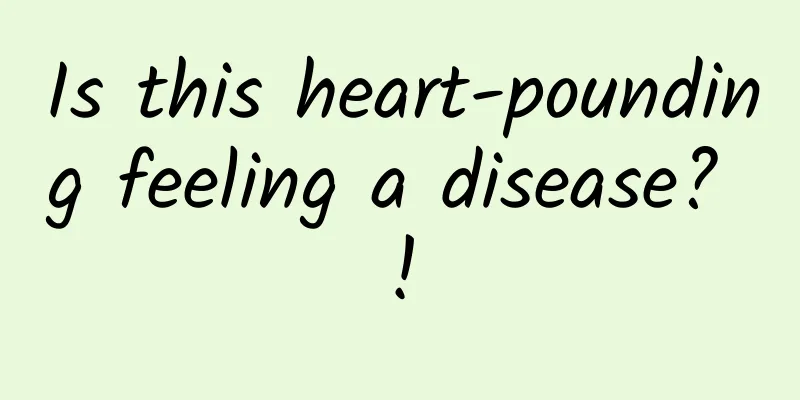Is this heart-pounding feeling a disease? !

|
"I feel my heart fluttering from time to time, but I haven't met my 'Soulmate', let alone fallen in love?" "Doctor, am I sick? Is there something wrong with my heart?" Some even told me: "Doctor, I feel like a thief, I feel very uneasy, I can't concentrate on work or study, and it has affected my daily life." Whenever I meet this type of patients, I feel very sympathetic and understanding for them, because I often feel this kind of "heart flutter". ask: What is the feeling of being moved? So what does this "heart-pounding" feeling feel like? Is lying on the bed or sitting on a stool and feeling your heart pounding the feeling of "heart-pounding"? No, Medically, it is called "heart palpitations". Heart palpitations are a subjective feeling of a strong, irregular and uncomfortable heartbeat, which can be manifested as a rapid thumping sensation in the chest (thumping), a heavy thumping sensation in the chest or neck, etc. Some people may experience chest pain, chest tightness, sweating, difficulty breathing, dizziness, and lack of strength. If you experience heart palpitations from time to time at rest, with slight emotional fluctuations, or with slight exercise, it may be inappropriate sinus tachycardia. ask: What is inappropriate sinus tachycardia? Nonparoxysmal sinus tachycardia (NPST), also known as idiopathic sinus tachycardia (IST), is a clinical syndrome that has not yet been clearly defined. It refers to an excessive increase in resting heart rate during activity or mental stress. A sinus heart rate > 100 beats/min without other causes of tachycardia is a rare and special type of sinus tachycardia. Criteria for the diagnosis of inappropriate sinus tachycardia include: 1. Ventricular rate >100 beats/min at rest or with light activity. 2. During tachycardia, the P wave morphology of the electrocardiogram is sinus. 3. There are corresponding symptoms when tachycardia occurs. 4. Other causes of obvious sinus tachycardia need to be ruled out, such as heart failure, hyperthyroidism, anemia, etc. 5. Determine the intrinsic heart rate of the sinus node. After completely blocking the autonomic nerves of the sinus node with atropine or beta-blockers, measure the intrinsic heart rate of the sinus node. Use different doses of isoproterenol to evaluate the effect on heart rate and the response of heart rate after exercise. Many patients with inappropriate sinus tachycardia have an increased intrinsic heart rate and abnormally increased sensitivity to isoproterenol, which helps with diagnosis. ask: What causes inappropriate sinus tachycardia? Its pathogenesis is still unclear, and there are three main theories: 1. Abnormal self-regulatory function mediated by the autonomic nervous system Due to excessive sympathetic nerve tension or low vagus nerve tension, the heart rate cannot respond normally when the external environment changes. The research results show: Inappropriate sinus tachycardia is mainly related to the abnormal regulation of the autonomic nervous system on the sinus node rhythm, and a few are accompanied by abnormal intrinsic heart rate of the sinus node. Sgarbossa et al. analyzed the heart rate variability of patients with inappropriate sinus tachycardia through 24-hour dynamic electrocardiogram and believed that the level of heart rate variability was related to vagal nerve tone. It is directly proportional to the level of vagus nerve tension and inversely proportional to the level of sympathetic nerve tension. Compared with normal controls, their heart rate variability is significantly reduced, reflecting the vagus nerve tension. Abnormally low, supporting the view that inappropriate sinus tachycardia is mediated by autonomic dysfunction. 2. Increased sinoatrial node automaticity Studies have shown that the mechanism of inappropriate sinus tachycardia is related to primary sinus node abnormalities (autonomic abnormalities can only occur if the sinus node itself is abnormal). The normal sinoatrial node does not have autonomic dysfunction), characterized by an increased intrinsic heart rate, decreased cardiac vagal reflex outflow, and β-receptor Increased adrenal sensitivity. 3. Right atrial tachycardia Some people believe that inappropriate sinus tachycardia is not sinus rhythm, but atrial tachycardia originating from the atrium very close to the sinoatrial node. The morphology of the P wave on the electrocardiogram is very similar to the morphology of the sinus P wave. It is currently believed that in terms of narrow standards, even ectopic atrial tachycardia very close to the sinoatrial node cannot be classified as inappropriate sinus tachycardia. However, even with the current intracardiac electrophysiological examination method, it is not necessarily possible to distinguish inappropriate sinus tachycardia from right atrial tachycardia. Therefore, it cannot be denied that some inappropriate sinus tachycardia may have right atrial tachycardia. ask: What diseases need to be differentiated? Different diseases have different treatment plans. What diseases should be differentiated from inappropriate sinus tachycardia is probably a question that everyone is more concerned about. 1. Sinus tachycardia The heart rate of a normal sinus tachycardia is 100 to 150 beats/min, and the ventricular rate usually does not exceed 100 beats/min during rest or light activity. The cause of sinus tachycardia is usually easy to identify. 2. Intraatrial reentrant tachycardia Intraatrial reentrant tachycardia has a heart rate of 140 to 250 beats/min. The P' wave morphology is different from the sinus P wave and may be induced or terminated by timely premature atrial contractions. Seizures can be induced and terminated by programmed stimulation. 3. Sinoatrial reentrant tachycardia The heart rate of sinus reentrant tachycardia is 100-140 beats/min, mostly around 120 beats/min. The P' wave morphology is the same or similar to the sinus P wave. Paroxysmal seizures occur suddenly and stop suddenly, and the duration of the seizure is short. Atrial premature contractions can induce and terminate tachycardia. Programmed stimulation can induce and terminate its seizures. 4. Autonomic atrial tachycardia Differentiating between spontaneous atrial tachycardia and inappropriate sinus tachycardia is difficult. Spontaneous atrial tachycardia occurs with a gradual increase in rate (“warm-up”) Or "warm awakening" phenomenon), after 3 to 5 cardiac cycles, the heart rate gradually increases and stabilizes at a certain level (fixed heart rate), and gradually slows down before termination. There is a long compensatory interval at termination. Inappropriate sinus tachycardia, the heart rate gradually increases when the sympathetic nerves are excited; when the vagus nerves are excited, the heart rate gradually decreases. The dynamic electrocardiogram shows a fast heart rate and large day and night changes. ask: Which type of people are prone to "inappropriate sinus tachycardia"? About 90% of patients are women, aged around 20-45 years old. The most common symptom in the medical history is palpitations, followed by chest tightness, fatigue, dizziness, etc. Many patients present with symptoms of mental tension, and the symptoms are numerous and complex, which are inconsistent with the severity of the tachycardia. Some patients have intermittent symptoms, while others are long-term and persistent, with a course of 1 to 11 years. Mild inappropriate sinus tachycardia may have no symptoms. It is worth noting that the actual incidence of inappropriate sinus tachycardia may be higher than people estimate, accounting for 1.16% of middle-aged people, and may also occur in the elderly. Clinical manifestations of inappropriate sinus tachycardia Inappropriate sinus tachycardia is the main clinical manifestation of this disease, which has the following characteristics: 1. The heart rate is greater than 100 beats/min when resting or doing light activity. 2. The 24-hour dynamic electrocardiogram shows that the average heart rate is significantly increased, the heart rate is abnormally high during the day and relatively low at night. The heart rate of some patients can drop to the normal range. 3. Short-term exercise (5 minutes of walking or treadmill exercise test) causes a disproportionate increase in heart rate, with the average heart rate reaching 140 beats/min. 4. The heart rate is relatively low when lying down, at 60 to 135 beats/min; the heart rate is significantly higher when standing upright, at 90 to 160 beats/min. 5. Tachycardia may be intermittent, continuous, or continuous. 6. When combined with arrhythmic cardiomyopathy and heart failure, the heart rate may often continue to increase to 160-220 beats/min, impairing cardiac function. 7. Poor response to treatment with beta-blockers or calcium ion antagonists. ask: What inspection items should be done? When you feel uncomfortable with palpitations or suspect that you have inappropriate sinus tachycardia, what tests should you do at the hospital? First, complete the 12-lead and dynamic 24-hour electrocardiogram. These two tests can help diagnose inappropriate sinus tachycardia and exclude other diseases that cause myocardial discomfort, such as premature atrial beats, premature ventricular beats, paroxysmal supraventricular tachycardia, sinus bradycardia, etc. Second, improve the treadmill exercise test: evaluate the response to exercise and whether the heart rate is over-reactive; Third, complete the cardiac color Doppler ultrasound examination: exclude other causes of heart disease such as congenital heart disease, severe valvular insufficiency, heart size, etc.; Fourth, complete relevant blood tests to exclude diseases that may cause heartbeat changes, such as blood routine tests (whether there is anemia), thyroid hormones (whether there is hyperthyroidism), etc. Fifth, if necessary, intracardiac electrophysiological examinations can be performed. Theoretically, when tachycardia occurs, mapping the pacing site in the high right atrium or close to the suspected pacemaker of the sinoatrial node can determine the origin of the excitement. However, since the sinoatrial node is a diffuse structure with non-specific anatomical location and there is no clear boundary between it and the atrial tissue, and the responses of inappropriate sinus tachycardia and ectopic right atrial autonomic tachycardia to external stimuli are very similar, it is difficult to distinguish between the two. Treatment of inappropriate sinus tachycardia Currently, inappropriate sinus tachycardia is mainly controlled by drugs. 1. Drug treatment The first choice is beta-blockers, such as metoprolol (Betaloc), atenolol (Atenolol), propranolol (Inderalol), etc. Its pharmacological mechanism is Affects the autonomy and/or autonomic tension of the sinoatrial node. However, most patients respond poorly to treatment and often need to increase the dose. Excessive doses of β-receptors Blockers or calcium ion antagonists can cause systemic symptoms such as fatigue and headache, which patients cannot tolerate. In addition, they can also cause a decrease in blood pressure and sympathetic nerve excitement. directly affect the control of inappropriate sinus tachycardia. Calcium ion antagonists also have a certain effect. If the above treatment is ineffective, amiodarone or propafenone can be used Lowers heart rate. Be aware of adverse reactions when taking it for a long time. 2. Non-drug treatment Non-drug treatments include surgical sinus node resection, pacemaker placement after partial right atrium resection, chemical sinus node artery embolization, closure surgery, etc. However, it causes great trauma and many complications. 3. Radiofrequency ablation Radiofrequency ablation has good efficacy. During the operation, the sinus rate steadily decreases by 20% to 40%, which can be considered a successful ablation modification. Although the efficacy is encouraging, However, 30% of patients still have recurrence after surgery. ask: How to Prevent Inappropriate Sinus Tachycardia? The cause of inappropriate sinus tachycardia is still unclear, and there is no effective prevention method. If you have inappropriate tachycardia, you should avoid mental stress in your daily life; quit smoking and drinking to reduce the inducing factors of this disease; have a regular daily life, eat properly, and avoid overwork; exercise appropriately to prevent colds. A small number of patients in the middle and late stages may develop arrhythmic cardiomyopathy, refractory heart failure, etc. due to long-term tachycardia. Therefore, if serious complications occur, you must strictly follow the doctor's advice to take medicine. Prognosis of inappropriate sinus tachycardia If inappropriate sinus tachycardia is caused by sympathetic nerve excitement, beta-blocker treatment can be effective, but the dose still needs to be increased to be effective; if it is caused by low vagal tone, drug treatment is more difficult. A small number of patients will suffer from arrhythmic cardiomyopathy due to long-term tachycardia, especially endless sinus tachycardia, which will damage heart function, cause heart failure, shock, etc., and have a serious prognosis. Most of them tend to be chronic, but the prognosis is mostly benign. So, don't worry too much. |
<<: Conviva: TikTok Benchmarks and Brand Strategy Guide
Recommend
I was tricked into doing postpartum rehabilitation
Today's women pay more and more attention to ...
MusicWatch: In Q4 2024, TikTok's music user market share will drop to 29%, while Meta's will rise to 36%.
According to the latest research from data analysi...
Causes of bleeding 20 days after blastocyst transfer
Need to look at the blood HCG value. If you are n...
There are blood clots like meat in menstruation
Menstrual blood clots require not only medication...
How many fetal movements per hour is normal?
Feeling your baby's slight movements in your ...
The best time to enlarge breasts after weaning
After the baby is 2 years old, the mother will we...
The low blood pressure is close to 100, but the high blood pressure is normal. Is it dangerous? What should I do?
A friend left a message to Huazi saying that his ...
Does diarrhea affect implantation?
Diarrhea is a digestive tract disease that everyo...
What are the characteristics of Mount Tai? When is the best month to climb Mount Tai?
Mount Tai rises above the Qi and Lu hills, with a...
Does low progesterone affect follicle development?
Low progesterone is caused by luteal insufficienc...
What are the black spots on strawberries? When is the strawberry season?
Strawberries are not only rich in nutritional val...
How to get a perfect body in less than a month
"Weight Loss Hot Pot Herbal Tea, Weight Loss...
What are the misunderstandings about the medication for candidal vaginitis
Candidal vaginitis is a relatively common gynecol...
Brown discharge after taking pregnancy medication
Important reminder: Brown discharge during pregna...
What are the ways to delay ovarian aging?
For women, nothing scares them more than aging. W...









